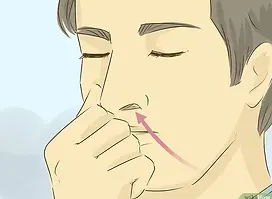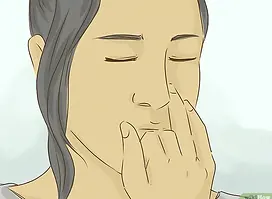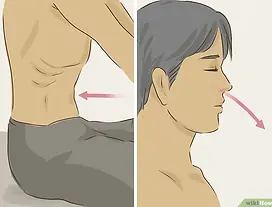Desire to Yoga


Anulom Vilom/ Nadi Shodhna (Alternate Nostril Breathing)
Anulom Vilom, also known as Nadi Shodhana or alternate nostril breathing, is a calming and balancing pranayama (breathing exercise) in yoga.
Here are the steps to practice Anulom Vilom:

Sit comfortably in an easy cross-legged position with your back straight.
Place your left hand on your lap or knee.
If uncomfortable, use a yoga block or chair for support.
Consider forming an "okay" gesture with your thumb and pointer finger.
Nadi shodhana pranayama aids in quieting the mind and easing tension during meditation.

Close your right nostril with your right thumb.
Rest your index and middle fingers on your forehead or fold them and rest your knuckles just below your nose.
Place your thumb on the slight indentation below the bone at the top of your nose.

Inhale through your left nostril slowly and steadily.
Count to 4 or 5 to ensure consistency in your breath.
Increase breath length with experience.

Close your left nostril with your right ring finger and release your right nostril.
At the top of the inhale, block both nostrils gently with the inside of your right ring finger.
Hold your breath briefly.
Release your right nostril, leaving your left nostril blocked.

Exhale through your right nostril.
Pause briefly. Inhale through your right nostril without changing hand position.
Match the length of your exhale to your inhale.
Counting to 4 or 5 can help maintain consistency.

Block your right nostril and exhale through your left nostril.
Complete a full exhale through your left nostril.
This completes one cycle of the pranayama.
Repeat this process 3 to 5 times.
Resume regular breathing afterward.

Kapalbhati (Skull Shining Breath)
Kapalabhati, often referred to as "skull shining breath" or "breath of fire," is a yogic breathing technique involving rapid, forceful exhalations followed by passive inhalations. It aims to cleanse the respiratory system, energize the body, and focus the mind. By forcefully contracting the lower belly, air is expelled from the lungs in short bursts, promoting digestion, detoxification, and mental clarity.
Sit comfortably with a straight spine.
Choose an easy cross-legged position on the ground or use a yoga block or chair for support.
Keep your shoulders rolled back.
Kapalabhati should be practiced in a seated pose to engage stomach muscles and release toxins from the body.

Suck in your lower belly quickly to push a sharp burst of air through your nose.
Pull your abdomen inward with an active and forceful breath.
Avoid using your chest, shoulders, neck, or face.
Place your hands on your lower belly to ensure correct muscle engagement.
If needed, cup one hand lightly in the other and press it gently against your lower belly.

Release the contraction after exhaling.
Allow the breath to flow back into your lungs naturally.
Inhale smoothly and effortlessly through your nose.
Keep your lips sealed throughout the practice.

Repeat the breath cycle 11 times.
Take a break to breathe normally afterward.
Pace yourself slowly, aiming for 1 exhale-inhale cycle every 1 to 2 seconds.
Increase your pace to 2 exhale-inhale cycles per second with experience.
If you feel dizzy or lightheaded, pause and breathe normally for a minute or two.
Complete 3 rounds of 11 breaths in each session.
